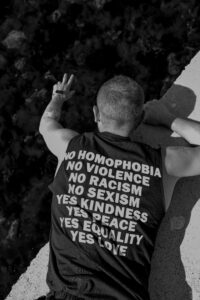THE IMPORTANCE OF DIVERSITY AND REPRESENTATION IN THE MEDIA
WHY IS REPRESENTATION ESPECIALLY SIGNIFICANT?
Our view of the world is influenced by external stimuli and the media industry knows that very well. The social impact of what we are surrounded by is becoming more and more crucial in shaping our cultural ideology and in influencing how people see themselves and interact with others. However, the lack of representation and the presence of stereotypes are creating a social divide among communities.
UNDER-REPRESENTATION
 How would you feel if you did not see anyone like you in the media industry? That is the case for many people, especially minorities, people of colour, and women. Just to name a few. As claimed by UCLA’s Hollywood Diversity Report, the percentage of jobs given to people of colour and women in the acting industry has been increasing.
How would you feel if you did not see anyone like you in the media industry? That is the case for many people, especially minorities, people of colour, and women. Just to name a few. As claimed by UCLA’s Hollywood Diversity Report, the percentage of jobs given to people of colour and women in the acting industry has been increasing.
According to this research, from 2018 to 2019:
- the lead roles played by women grew from 41.0 to 44.1 percent;
- the roles played by people of colour grew from 30.9 to 32 percent.
However, it is still clear that Hollywood has issues with including diversity in its casts. For example, when it comes to the gender gap, the research showed that white people hold 91 percent of the chief roles in the studios and 82 percent of them were men. Also, the 2020 Oscar nominations are a result of this lack of representation: there were no female nominees for best director and only 2 of the 20 nominated actors and actresses were people of colour.
MISREPRESENTATION AND STEREOTYPES
 The lack of representation is not the only issue. The media industry has a tendency to stereotype some characters, often delivering an offensive and inaccurate depiction of them. Blackface is a case in point. This theatrical makeup consists of using paint to make one’s skin look darker and to overemphasise face features. Its history goes back to the 19th century when, in minstrel performance shows, white actors used to represent people of colour mocking them and widening the already existing inequality gap among Americans. Unfortunately, the problem is still real today. In fact, in 2017, an Italian comedian published a blackface satire video. And although the comedian stated that the video had satirical intentions, racial stereotypes are clearly not the most appropriate way to deal with problems of inclusion and diversity. Misrepresentation is an issue also for the LGBTQ+ community: 2019-2020 Where We Are on TV report showcased that there were only 38 transgender characters and that 31 of them were played by actual transgender actors. Performers should be able to play all the roles, but representing the diversity of the real world is what requires urgent attention.
The lack of representation is not the only issue. The media industry has a tendency to stereotype some characters, often delivering an offensive and inaccurate depiction of them. Blackface is a case in point. This theatrical makeup consists of using paint to make one’s skin look darker and to overemphasise face features. Its history goes back to the 19th century when, in minstrel performance shows, white actors used to represent people of colour mocking them and widening the already existing inequality gap among Americans. Unfortunately, the problem is still real today. In fact, in 2017, an Italian comedian published a blackface satire video. And although the comedian stated that the video had satirical intentions, racial stereotypes are clearly not the most appropriate way to deal with problems of inclusion and diversity. Misrepresentation is an issue also for the LGBTQ+ community: 2019-2020 Where We Are on TV report showcased that there were only 38 transgender characters and that 31 of them were played by actual transgender actors. Performers should be able to play all the roles, but representing the diversity of the real world is what requires urgent attention.
Stigma is equally a major problem in the media industry when it comes to the representation of disabilities. Disability has been reported to be associated with stereotypes such as anti-hero, superpower, and commiseration for the condition.
HOW TO TACKLE THE PROBLEM
 First and foremost, it is essential to understand the impacts of the media industry on our everyday life, as it is often the major source of information for people on matters they know nothing about. While people tend to fear and criticise what is different, you should learn more about stereotypes and their history in order to deeply understand them and to realise how one’s behaviour can affect these people’s feelings. Discussing with people of a specific community with a thoughtful and sympathetic attitude is the way to do that. The purpose should be that of learning and making a real connection with others, so as to reduce social gaps and inequality. We should learn more about the history and experiences of social groups we are not part of. And even if one does not feel involved in the issues of mis- and under-representation, they should be aware of their social privilege. For many, being represented means feeling accepted and not alone. It means hope and it proves that everyone has the right to pursue their happiness, regardless of their roots, background, gender, or disabilities.
First and foremost, it is essential to understand the impacts of the media industry on our everyday life, as it is often the major source of information for people on matters they know nothing about. While people tend to fear and criticise what is different, you should learn more about stereotypes and their history in order to deeply understand them and to realise how one’s behaviour can affect these people’s feelings. Discussing with people of a specific community with a thoughtful and sympathetic attitude is the way to do that. The purpose should be that of learning and making a real connection with others, so as to reduce social gaps and inequality. We should learn more about the history and experiences of social groups we are not part of. And even if one does not feel involved in the issues of mis- and under-representation, they should be aware of their social privilege. For many, being represented means feeling accepted and not alone. It means hope and it proves that everyone has the right to pursue their happiness, regardless of their roots, background, gender, or disabilities.


